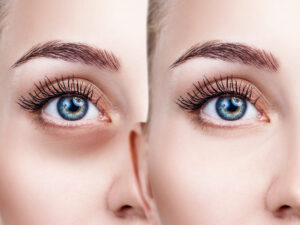The outcome of getting a facelift should be exciting and rejuvenating, but from time to time the results aren’t what you expected. Sometimes an undesired outcome is the result of having a doctor who didn’t specialize in facial plastics, or one who doesn’t utilize the latest techniques. Fortunately, a facelift revision is possible to correct the unsatisfactory or unaesthetic outcomes from surgery, if you choose a surgeon who has the proper expertise.
Signs You May Benefit From a Facelift Revision
People may experience problems shortly after a facelift or begin to notice issues years later. Some of the most common signs that you may want to get a facelift revision include:
Noticeable Scarring
Sometimes, it isn’t immediately apparent if unattractive scarring from a facelift will be permanent. But if your facial swelling subsides and you see scarring that is prominent, it may be because too much tension has been placed on the incisions from tightening the surface of the skin.
Deterioration of Initial Results
Some people who are initially wowed with their results sometimes find their stunning benefits from a facelift deteriorate quickly and facial sagging returns. Some settling after your facelift is normal, but the return of excessive sagging soon after a facelift shouldn’t be expected.
Cobra Neck Deformity
A noticeable indentation in the middle of your neck, with sagging or jowly skin hanging on either side of the center of the neck may be a sign that corrective surgery is warranted. This development is known as cobra neck, which is a deformity that can be caused from a facelift when too much fat is removed from the neck, or because of inadequate lifting in the procedure.
Under Eye Sagging
If you begin to notice prominent sagging in a crescent shape along the cheekbone under the eye, it may be a sign your facelift is not aging well or that a surgeon didn’t adequately tighten muscles under the eyes. This is known as the malar crescent and can be corrected with a facelift revision.
Sunken or Hollow Eyes
Noticing sunken or hollowness with drooping skin and prominent bony structures surrounding the eye may be the result of the removal of too much fat padding around the eyes or from skin becoming thin and inelastic over time.
Lateral Sweep
If you see parallel lines that look stretched or taut along the cheeks to the ear, these may be created by improper tension created by a facelift. A lateral sweep is when the skin essentially pleats as it descends without appropriate support.
Pointed Ear Lobes
Ear lobes that appear unnaturally pointy can occur after skin-only lifts when the skin has been stretched too tightly, creating too much tension and leading to this “pixie ear” deformity.
When You Should Get a Facelift Revision
When a facelift has been done well, you may be able to see the revitalizing benefits for more than a decade. But if you have any of the above signs or unaesthetic results following a facelift, it’s worth getting a consultation to correct issues that you want to resolve. Dr. Matt Hershcovitch is double board-certified by the American Board of Facial Plastic and Reconstructive Surgery and the American Board of Otolaryngology and is commended in the greater Los Angeles area for his expertise in facelift revision.
No matter the reason why a facelift revision is desired, it’s important to get a revision at the right time. You shouldn’t have a revision within six months of the original facelift, and it is sometimes recommended to wait at least a year. This gives your body an opportunity to heal properly and to ensure that the face has settled so that the surgeon can better see the issues that need to be addressed.
If you’ve had a facelift in the past and were happy with results initially, but after five to 10 years, you begin to see sagging that you’d like to correct, you may consider a secondary facelift, which can offer another rejuvenating boost.
How a Facelift Revision is Performed
Oftentimes, what leads to the need for a facelift revision is the use of the wrong kind of procedure or technique in the first place. Not every technique can offer the same benefits for each patient. It’s important to choose a surgeon like Dr. Hershcovitch who is dedicated to a nuanced and detailed approach so that you get the procedure that’s right for you. This attention to detail is especially important with revision surgeries as a prior facelift can make the skin and muscle structures more delicate.
Sometimes more dissection is needed in a revision but every facelift revision will be approached differently, based on the issues that need to be addressed as well as how long it has been since the original surgery. When performing surgery to provide better tightening of the skin, Dr. Hershcovitch drapes and tightens the tissue carefully to prevent inappropriate tension and visible scarring from new incisions. All of our revisions surgeries are performed in a high-end cosmetic surgery center.
Contact us for a Facelift Revision Consultation.
Our goal with facelift revision is to help patients reach the natural-looking and harmonious outcome that they expected from their first surgery. Dr. Hershcovtich has special expertise in facelift revision. He has written chapters in medical textbooks on the topic and has had his studies featured in highly respected scientific journals. His extensive experience in a spectrum of plastic surgery techniques means that he can address a variety of cosmetic issues requiring facelift revision using the specific approach that will be best for each patient.
If you’re ready for a facelift revision consultation, contact our office in Burbank.
Burbank: (818) 206-2539.


